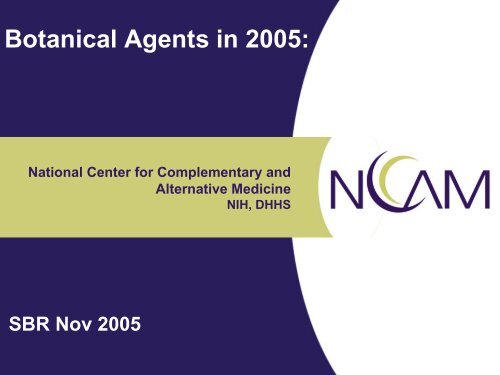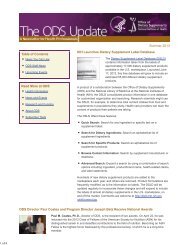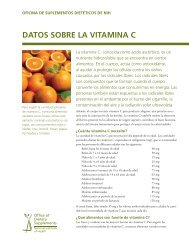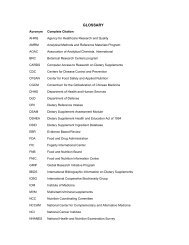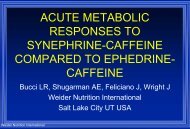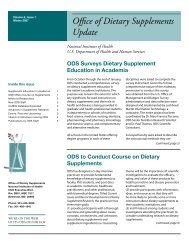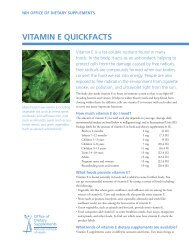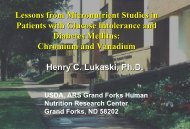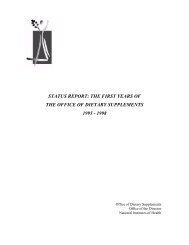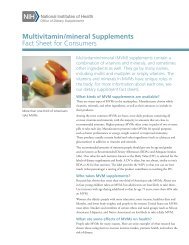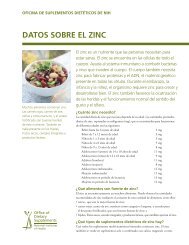Complementary and Alternative Medicine - Office of Dietary ...
Complementary and Alternative Medicine - Office of Dietary ...
Complementary and Alternative Medicine - Office of Dietary ...
Create successful ePaper yourself
Turn your PDF publications into a flip-book with our unique Google optimized e-Paper software.
Botanical Agents in 2005:<br />
National Center for <strong>Complementary</strong> <strong>and</strong><br />
<strong>Alternative</strong> <strong>Medicine</strong><br />
NIH, DHHS<br />
SBR Nov 2005
The CAM<br />
Domains
Botanical Agents<br />
• The FDA characterizes a product<br />
primarily based on its intended use.<br />
• A botanical product (vitamin, mineral,<br />
herb, amino acid), may be intended to<br />
be used as:<br />
• dietary supplement (food)<br />
• drug.
Herbal vs Conventional Agents<br />
• Herbal agents<br />
• Complex mixtures<br />
• First used (as dietary supplements), then<br />
investigated for safety <strong>and</strong> efficacy<br />
• Conventional drugs<br />
• Single agents<br />
• First investigated for safety <strong>and</strong> efficacy,<br />
then used
Issue #1<br />
• Does the use <strong>of</strong> Botanical Agents as<br />
dietary supplements provide data<br />
sufficient to inform the public about the<br />
medical benefits <strong>of</strong> Botanical Agents
<strong>Dietary</strong> Supplements<br />
• FDA regulates dietary supplements under a different set <strong>of</strong><br />
regulations than drug products (prescription <strong>and</strong> Over-the-<br />
Counter).<br />
• Under the <strong>Dietary</strong> Supplement Health <strong>and</strong> Education Act <strong>of</strong><br />
1994 (DSHEA), the dietary supplement manufacturer is<br />
responsible for ensuring that a dietary supplement is safe<br />
before it is marketed.<br />
• Generally, manufacturers do not need to register with FDA<br />
nor get FDA approval before producing or selling dietary<br />
supplements.<br />
• FDA is responsible for taking action against any unsafe dietary<br />
supplement product after it reaches the market.
<strong>Dietary</strong> Supplements<br />
GMP Benefits<br />
Table 13: Summary <strong>of</strong> annual benefits<br />
$ Million<br />
Fewer illnesses (from table 8) $39<br />
Fewer illnesses (from table 10) $66<br />
Fewer product recalls (from table 9) $3<br />
Reduced consumer search (from table 12) $109<br />
Total Benefits $218
<strong>Dietary</strong> Supplements GMP<br />
[FDA Document <strong>of</strong> 7 Mar 03]<br />
Requirements for:<br />
(1) personnel<br />
(2) the physical plant <strong>and</strong> environment<br />
(3) equipment <strong>and</strong> utensils<br />
(4) production <strong>and</strong> process controls<br />
(5) holding <strong>and</strong> distributing<br />
(6) consumer complaints related to<br />
CGMPs<br />
(7) records <strong>and</strong> recordkeeping
<strong>Dietary</strong> Supplements: GMP Cost<br />
Table 1.--Estimated Annual Recordkeeping Burden<br />
21 CFR Section Number <strong>of</strong> frequency <strong>of</strong> Total annual Hours per Total hours<br />
recordskeepers recordkeeping<br />
records record<br />
111.15(b)(3).................... 231 12 2,772 0.1 277<br />
111.15(d)(3).................... 231 260 60,060 0.25 15,015<br />
111.25(d)....................... 213 365 77,745 0.5 38,873<br />
111.30(b)(2) <strong>and</strong> (b)(5)......... 707 260 183,820 0.5 91,910<br />
111.35(d)....................... 10 1 10 10 100<br />
111.35(e)....................... 367 260 95,420 0.25 23,855<br />
111.35(f)....................... 367 260 95,420 0.1 9,542<br />
111.35(i)(1).................... 367 10 3,670 0.25 918<br />
111.35(j)....................... 367 260 95,420 .25 23,855<br />
111.35(m)....................... 367 365 133,955 0.1 13,396<br />
111.37(c)....................... 286 365 104,390 0.5 52,195<br />
111.40(a)(3), (a)(4), (b)(2), 449 365 163,885 0.1 16,389<br />
111.45(a) \2\ <strong>and</strong> (b) \2\....... 200 1 200 30 6,000<br />
111.60(b)(2).................... 133 365 48,545 1 48,545<br />
111.60(d) \2\................... 133 1 133 3 399<br />
111.65(c)(7), (c)(10), <strong>and</strong> 133 365 48,545 0.1 4,855<br />
111.70(b)(5) through (b)(6), 245 260 63,700 0.1 6,370<br />
111.70(g)....................... 245 260 63,700 0.50 31,850<br />
111.74(a)....................... 200 12 2,400 0.1 240<br />
111.82(a)....................... 53 52 2,756 0.1 276<br />
111.85(a)....................... 53 260 13,780 0.1 1,378<br />
111.85(d) <strong>and</strong> (e)............... 53 260 13,780 0.5 6,890<br />
111.95(e)....................... 53 75 3,975 0.1 398<br />
111.95(f)(1).................... 93 75 6,975 0.5 3,488<br />
111.125......................... 220 4 880 0.1 88<br />
Total....................... .............. .............. .............. .............. 500,587
<strong>Dietary</strong> Supplements<br />
GMP Balance<br />
Table 18. Annual Benefits <strong>and</strong> Costs <strong>of</strong> Proposed<br />
Rule<br />
Benefits<br />
Costs<br />
$218 million<br />
$86 million
<strong>Dietary</strong> Supplements<br />
• As a result <strong>of</strong> proposed changes in GMP<br />
st<strong>and</strong>ards for dietary supplements,<br />
manufacturing <strong>and</strong> control <strong>of</strong> dietary<br />
supplements will approximate that <strong>of</strong> drugs.<br />
• Safety <strong>and</strong> efficacy considerations are<br />
unaffected by the 2003 proposed changes.
<strong>Dietary</strong> Supplements<br />
• FDA regulates dietary supplements under a different set <strong>of</strong> regulations<br />
than drug products (prescription <strong>and</strong> Over-the-Counter).<br />
• Under the <strong>Dietary</strong> Supplement Health <strong>and</strong> Education Act <strong>of</strong> 1994<br />
(DSHEA), the dietary supplement manufacturer is responsible for<br />
ensuring that a dietary supplement is safe before it is marketed.<br />
• Generally, manufacturers do not need to register with FDA nor get FDA<br />
approval before producing or selling dietary supplements.<br />
• FDA is responsible for taking action against any<br />
unsafe dietary supplement product after it<br />
reaches the market.
Ephedra: Clinical data<br />
• Efficacy<br />
• 0.9 kg/month wt loss<br />
• JAMA 2003;289:1537<br />
• Toxicity<br />
• 1 dose <strong>of</strong> metabolife 356 (12 mg ephedra<br />
plus 40 mg caffeine) : 8 <strong>of</strong> 15 have 30<br />
msec QTc prolongation vs 1 <strong>of</strong> 15 when<br />
xover to placebo<br />
• JAMA 2004; 291:216
Ephedra: Apr 2005<br />
• US District Court Judge in Utah ruled<br />
that FDA had not proven that 10 mg<br />
ephedra in DS were dangerous.<br />
• Burden <strong>of</strong> pro<strong>of</strong> is on govt, via intent <strong>of</strong><br />
Congress in regulating DS as food, to<br />
prove danger <strong>of</strong> DS.
Issue #1<br />
• Does the use <strong>of</strong> Botanical Agents as<br />
dietary supplements provide data<br />
sufficient to inform the public about the<br />
medical benefits <strong>of</strong> Botanical Agents<br />
• Ans: NO
Botanicals used as a Drug:<br />
Data needed to Support<br />
Clinical Trials<br />
• There are 3 main sections to a dossier submitted to<br />
the FDA to support an IND or an NDA:<br />
• CMC (chemistry-manufacturing-control) data<br />
• Preclinical / Nonclinical data<br />
• Clinical data
Botanicals used as a Drug:<br />
FDA Guidance Doc June 2004<br />
• “Botanical drug products <strong>of</strong>ten have unique features”<br />
• Complex mixture with lack <strong>of</strong> a distinct “active ingredient ”<br />
• “substantial prior human use” as a dietary supplement<br />
• In the FDA guidance, CMC, preclinical, <strong>and</strong> clinical<br />
documentation is:<br />
• greater than that needed for clinical use <strong>of</strong> a dietary<br />
supplement,<br />
• reduced compared to that needed for synthetic conventional<br />
drugs.
SUBJECT<br />
Considerations for Botanical drug<br />
Clinical Research:<br />
Chemistry Manufacturing Control<br />
DRUG<br />
STUDIES<br />
STUDY<br />
DETAILS<br />
Data needed<br />
to support<br />
PHASE I / II<br />
Data needed<br />
to support<br />
PHASE III<br />
PLANT<br />
SUBSTANCE<br />
Starting<br />
material<br />
Botanical<br />
description<br />
Procedure<br />
Quantity <strong>of</strong> active<br />
Identity: Chem (IR,<br />
MS, NMR, UV,<br />
Chiral); biologic<br />
Stability<br />
X<br />
X<br />
Exp<strong>and</strong>ed<br />
Exp<strong>and</strong>ed<br />
X<br />
X<br />
X.<br />
PLANT<br />
PRODUCT<br />
Manufacturing<br />
Finished prod<br />
Product assay<br />
Storage<br />
Stability<br />
Excipients<br />
Impurities<br />
Inprocess controls<br />
Reference stan<br />
Bioavailability<br />
Container<br />
Microbiology<br />
Environmental<br />
Reagents/flow<br />
Quantity <strong>of</strong> active<br />
Methods/Specs<br />
Identity (chemical)<br />
Purity<br />
describe<br />
Light/heat/time<br />
List<br />
List/analyze<br />
SOPs<br />
St<strong>and</strong>ard batch<br />
Dissolution rate<br />
Label<br />
Contamination<br />
Assessment<br />
X<br />
X<br />
X<br />
X<br />
X<br />
X<br />
X<br />
X<br />
X<br />
X<br />
X.<br />
X<br />
X.<br />
X.<br />
X<br />
X<br />
X<br />
X<br />
X<br />
X
Considerations for Botanical drug<br />
Clinical Research:<br />
Chemistry Manufacturing Control [2005]<br />
• 1. Identification (genus, species, variety-if applicable)<br />
• 2. Study agent supplier. This information should extend back to the raw material harvest, if<br />
possible.<br />
• 4. Reference specimen <strong>of</strong> the source material.<br />
• 5. Pharmacopeial monograph (e.g., U.S. Pharmacopeia)<br />
6. Description (macroscopic) <strong>of</strong> the parts <strong>of</strong> the plant from which the product is derived.<br />
• 7. Geographic source <strong>of</strong> the material, time <strong>of</strong> harvest, plant part<br />
• 8. Compliance with the WHO Guidelines on Good Agricultural <strong>and</strong> Collection<br />
Practices<br />
• 9. Extraction procedure<br />
• 10. Formulation <strong>of</strong> finished product.<br />
• 11. Active <strong>and</strong>/or other relevant marker compound(s) used for st<strong>and</strong>ardization.<br />
• 12. Chemical pr<strong>of</strong>ile or fingerprint <strong>of</strong> the agent<br />
• 13. Process controls<br />
• 14 Contaminants or adulterants.<br />
• 15. Certificate <strong>of</strong> Analysis<br />
• 16. Bioavailability, dissolution<br />
• 17. Stability.<br />
• 18. Storage conditions<br />
• 19. Batch-to-batch reproducibility.<br />
• 20. Reserve samples
Issue #2:<br />
• How much CMC documentation should<br />
be required for Botanical agents used<br />
for Preclinical studies, Initial (Phase I /<br />
II) clinical trials, <strong>and</strong> Pivotal (phase III)<br />
clinical trials
Botanicals used as a Drug:<br />
FDA Guidance Doc June 2004<br />
• Many botanical products are legally available in the United<br />
States as dietary supplements. Given the wide availability <strong>of</strong><br />
such products outside <strong>of</strong> clinical trials, it is important to assess<br />
effectiveness…<br />
• To support initial clinical trials, the nonclinical<br />
pharmacology <strong>and</strong> toxicology information that<br />
must be provided …may be markedly reduced<br />
compared to that for new drugs for which there<br />
is no prior human experience.<br />
• In most cases, additional toxicology <strong>and</strong> CMC<br />
data will not be required for such initial trials.
Considerations for Botanical Drug<br />
Clinical Research: Non-Clinical<br />
SUBJECT DRUG STUDIES STUDY<br />
DETAILS<br />
Data needed to<br />
support<br />
PHASE I / II<br />
Data needed<br />
to support<br />
PHASE III<br />
Efficacy<br />
In vitro<br />
In vivo animal<br />
Mechanisms<br />
2 species<br />
[literature review]<br />
Toxicity<br />
Single dose<br />
Multiple dose<br />
Reproduction<br />
Mutagenicity<br />
Carcinogenicity<br />
Cardiovascular tox<br />
Special target tox<br />
2 species<br />
2 species<br />
Segment 1, seg 2<br />
In vitro, in vivo<br />
Mice, rats<br />
Dog<br />
As needed<br />
[literature review]<br />
(may need)<br />
(may need)<br />
(may need)<br />
(may need)<br />
(may need)<br />
Pharmacokinetics<br />
(ADME)<br />
Metabolite synthesis<br />
Assay methods<br />
In vitro metabolism<br />
In vivo metabolism<br />
In vivo kinetics<br />
Distribution<br />
Toxicokinetics<br />
Efficacy kinetics<br />
In fungus<br />
In vitro, in vivo<br />
Metab, drug-drug<br />
Metab, drug-drug<br />
Absorption, excretion<br />
Radiolabel, protein<br />
2 species<br />
In vivo models
Botanicals used as a Drug:<br />
FDA Guidance Doc June 2004<br />
• Many botanical products are legally<br />
available in the United States as dietary<br />
supplements. Given the wide availability<br />
<strong>of</strong> such products outside <strong>of</strong> clinical trials,<br />
it is important to assess effectiveness…<br />
• To support initial clinical trials, the nonclinical pharmacology <strong>and</strong><br />
toxicology information that must be provided …may be markedly<br />
reduced compared to that for new drugs for which there is no<br />
prior human experience.<br />
• In most cases, additional toxicology <strong>and</strong> CMC data will not be<br />
required for such initial trials.
Considerations for Botanical drug<br />
Clinical Research:<br />
Clinical Considerations<br />
SUBJECT DRUG STUDIES STUDY<br />
DETAILS<br />
PHASE I<br />
Toxicity<br />
Single dose<br />
Multiple dose<br />
Impaired pops<br />
(renal, hepatic)<br />
Data needed<br />
to support<br />
PHASE I / II<br />
X<br />
Data needed to<br />
support<br />
PHASE III<br />
X<br />
(desireable)<br />
Pharmacok`inetics<br />
Fed/fasted,<br />
drug-drug<br />
(desireable)<br />
(desireable)<br />
Toxicokinetics<br />
Compare to toxicity,<br />
Compare to animals<br />
PHASE II Efficacy Multiple dose<br />
Increased pt # s<br />
X<br />
PHASE III Efficacy,Toxicity, PK Pivotal Trials: Adults<br />
Other trials;<br />
children<br />
renal/hepatic<br />
general pop
Issue #3:<br />
• How much preclinical efficacy <strong>and</strong><br />
toxicity data needs to be provided to<br />
support clinical trials <strong>of</strong> Botanical<br />
Agents
Considerations for Botanical<br />
Drug Clinical Research:<br />
ADDITIONAL NCCAM<br />
CLINICAL REQUIREMENTS RE:<br />
dose escalation<br />
placebo effect
St John’s Wort:<br />
results on HAM D score<br />
[response] SJW Placebo Sertraline<br />
N=113 N=116 N=109<br />
Any 43 (38%) 50 (43%) 53 (49%)<br />
Full 27 (24%) 37 (32%) 27 (25%)<br />
Partial 16 (14%) 12 (11%) 26 (24%)
Considerations for Botanical Drug<br />
Clinical Research:<br />
Need for Phase 2 trials<br />
• The purpose <strong>of</strong> a clinical trial is to evaluate an intervention for a<br />
clinical condition with the longer-range goal <strong>of</strong> improving human<br />
health <strong>and</strong> clinical practice.<br />
• Positive (or negative) data can lead to a recommendation to use<br />
(or not to use) the treatment.<br />
• Use <strong>of</strong> a suboptimal dose that is safe but ineffective does<br />
not serve the needs <strong>of</strong> the community. Although the trial<br />
indicates only that the tested dose <strong>of</strong> the intervention was<br />
ineffective, the community may conclude that all doses <strong>of</strong><br />
the intervention are ineffective, <strong>and</strong> patients will be denied<br />
possible benefit from the intervention.
Issues #4 <strong>and</strong> #5:<br />
• Are placebo controls needed in clinical<br />
trials <strong>of</strong> Botanical agents<br />
• Ans: YES<br />
• Should the Initial Clinical trial be doseescalation<br />
phase I / II<br />
• Ans: YES
Issue # 6: dose-escalation requires<br />
Revisit <strong>of</strong> preclinical issue<br />
• Higher than “customary” doses will be used in<br />
the clinical trial<br />
• Substantial human use <strong>of</strong> those higher doses<br />
will not be present<br />
• Need for animal toxicity data to support those<br />
higher than customary clinical doses<br />
• Need for optimal Phase 3 dose<br />
• drives phase 2 dose escalation study design,<br />
• which drives need for animal safety data
DS / BOTANICAL AGENTS<br />
USED AS DRUGS<br />
• DO PUBLISHED STUDIES SHOW<br />
EFFICACY<br />
• ARE THE STUDIES CONCLUSIVE ON<br />
THE BASIS OF OUR PRESENT<br />
CLINICAL TRIAL DESIGN<br />
REQUIREMENTS
<strong>Dietary</strong> supplements:<br />
nutrients<br />
• Diarrhea-prevent<br />
• Children undernourished<br />
• Zinc: 5-20 mg/d x 12-54 wks<br />
• Diarrhea incidence:Odds Ratio =0.82<br />
(0.72-0.93)<br />
• Diarrhea-treat<br />
• Children undernourished<br />
• Zinc: 20 mg/day<br />
• >7d diarrhea: relative risk = 0.61(0.39-<br />
0.93)
Botanical phase 3 Trials:<br />
Effective Conclusive<br />
• Soy is<strong>of</strong>lavones for cognition [JAMA 2004;<br />
292:65]<br />
• 25 g soy protein +[52 mg genistein-41 mg<br />
daidzein- 6 mg glycitein]: daily for 12 months<br />
Soy Placebo P<br />
Memory +5.5 +4.7 0.36<br />
Attention -2.5 -3.5 0.76<br />
Verbal +0.3 +0.2 0.85<br />
MMSE -0.4 -0.1 0.47<br />
Not effective. Yes conclusive.
Echinacea to prevent colds<br />
NEJM 2005;353:341<br />
NOT effective; NOT conclusive
GAIT: Response for mod-severe <strong>and</strong> mild pain .<br />
Data = % pts with 20% improvement in pain at 24<br />
weeks.<br />
All patients<br />
WOMAC Pain 301-400mm<br />
WOMAC Pain 125-300mm<br />
P 60% 54% 62%<br />
CE 70%** 69% 70%*<br />
G 64% 66% 64%<br />
CS 65% 61% 67%<br />
G+CS 67% + 79%# 63%<br />
** p= 0.008 CE vs. P<br />
+ p= 0.09 G+CS vs. P<br />
p = 0.06 CE vs. P<br />
# p = 0.002 G+CS vs. P<br />
* p= 0.04 CE vs. P<br />
CONCLUSIONS: Combination G+CS is effective in treating<br />
moderate to severe knee pain due to OA.
Omacor: a complex biologic<br />
agent approved as a drug
NCCAM BOTANICAL CLINICAL<br />
TRIAL PROGRAM: 2005<br />
• Phase I / II studies<br />
• Phase III studies (older)<br />
• Product Development programs<br />
• Phase I / II<br />
• If successful, phase III
NCCAM PHASE I / II<br />
BOTANICAL TRIALS<br />
• Echinacea vs placebo for cold<br />
• Black cohost for post menopausal anxiety<br />
• Pycnogenol for lympedema<br />
• Ginger for chemotherapy-nausea<br />
• PUFA for depression<br />
• a-lipoic acid for HIV neuropathy<br />
• Chromium <strong>and</strong> glucose tolerance<br />
• Oyster mushrooms to decrease lipidemia<br />
• Marine/botanical oils fo rhematoid arthritis
NCCAM PHASE I / II<br />
BOTANICAL TRIALS<br />
• IV minerals for fibromyalgia<br />
• Creatine for Huntington’s disease<br />
• Melatonin for insomnia<br />
• Valerian for insomnia<br />
• Diet (high carb/low fat vs low carb/high<br />
fat)<br />
• Kudzu for alcohol abuse<br />
• Taurine <strong>and</strong> diabetic neuropathy
NCCAM PHASE III<br />
BOTANICAL TRIALS<br />
• GAIT: Glucosamine/chondroitin for knee<br />
arthritis<br />
• GEM:Ginkgo Bilboa prevent Alzheimers<br />
• TACT: EDTA/Vitamins prevent 2 nd MI<br />
• Phytoestrogens <strong>and</strong> artherosclerosis<br />
• [Creatine <strong>and</strong> ALS]<br />
• [SAMe <strong>and</strong> Depression]
NCCAM PHASE III BOTANICAL<br />
PRODUCT DEVELOPMENT PROGRAMS<br />
• Cranberry [Ocean Spray]<br />
• Prophylaxis for UTI<br />
• Saw palmetto (Indena) <strong>and</strong> Pygeum<br />
africanum [Fournier]<br />
• Treatment for Benign Prostatic Hypertrophy<br />
• Silymarin [Madaus]<br />
• Treatment for liver disease due to Hepatitis C or<br />
NASH


